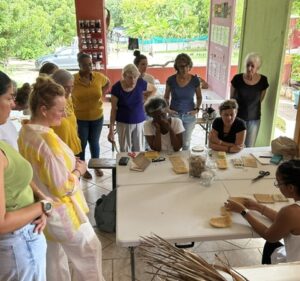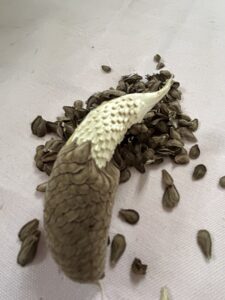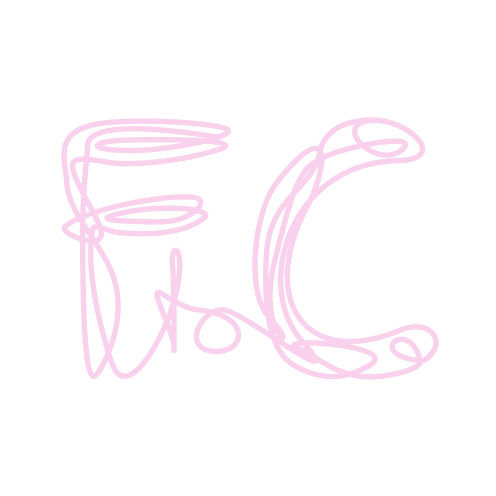Mix and Match: The Beauty of Curaçao Fibers
A coconut by the side of the road. Banana leaves on the ground. Designer Sanne Muiser views nature through the lens of fibers, and Curaçao is a treasure chest where fibers exist in large numbers. As a designing artist at the intersection of art, design, and research, she came to Curaçao in November 2023 to facilitate a workshop on needle felting. During this workshop, she uncovered a world of new textures, such as the softness of sansevieria, katuna di seda, and more.
Fascination
Sanne is the founder of Studio Pluis in Eindhoven, born out of a fascination with fibers; the fluff. ‘‘Fibers are the base of landscapes’’, says Sanne. She makes sense of the environment around her by exploring the landscape. Standing in the middle of the terrain, taking in everything with heightened senses. She begins a dialogue, from flora to fauna, with all the beings present. The landscape is not merely where she works, it’s the place the designer goes to gather knowledge. For the Dutch landscapes she explored sheep and wool fibres and retraced coffeebags to fique and jute. During her stay on the island she explored, together with Farm to Crafts, local fibres.
Participants in the two-day workshop started working with kapok fibers on the first day. First they removed the hard core from the white cotton that sticks out of the round fruits. The hard surface is detrimental to the needle. The feather-light brownish fluff floats with the wind and lands everywhere. “How primitive should the material be?” asks Marlies Schoenmakers. The ceramist is one of the 10 women following the first workshop series at the Farm to Crafts headquarters in Hòfi Cas Cora. The group consists mainly of artists and crafters, including artistic researcher and visual ethnographer Sharelly Emanuelson, ceramist Helen Martina, and art historian Josée Thissen-Rojer. Their curiosity about the needle felting technique brought them here.


Basic Instruments
Needle felting is a craft that transforms raw fibers into matted fabric, which can then be turned into virtually any two- or three-dimensional creation, from a tapestry to a wall hanging to a piece of clothing. Participants start small with just two instruments: a felting brush mat and felting needles. The brush mat is a small square brush where you first place the bonding material. In this case, participants use various leaves, including druifi di laman (sea grape), but also discarded burlap coffee bean sacks. Then the needle is repeatedly stabbed into the fiber; the barbs pull the fiber in but prevent it from sliding back out. This action tangles the fibers and causes the scales to interlock, resulting in felting.
In just two days, the group created works that wouldn’t look out of place in an art exhibition. A burlap bag with felting accents; an impressive (ritual) necklace by Eveline Sipkes made from sisal, palm leaf, coconut hair, kapok, and cotton; furry angel wings for Christmas decorations; a seascape painting, and experiments with synthetic and kinky natural hair.
Samples
For the second group, Sanne tightens the reins. The project’s starting point, learning by doing, takes center stage. The created samples provide a broader view of the usability of local natural materials. “The beauty of fibers resonated with them, but also the possibilities of the material became very apparent. They were guided by the joy of creating. That’s how they discovered the material’s potential with this new technique”, says Sanne.
Even she, a seasoned felter, got new insights. “Kapok from the trees here is amazing because it has its own color. The kapok I order from Indonesia is probably bleached first. The ones from Curaçao are soft and extremely fluffy. It needs something to stick to because it’s super stubborn. The katuna di seda surprised me. The shrub grows by the road and is seen as a weed. The fiber is beautifully packaged in the fruit. It’s ingenious how nature did that. The white fiber itself is very soft. In the Netherlands, it’s comparable to blowing a dandelion away. It gives a very nice accent by felting four layers on top of each other. It also works well with kapok. The colors match beautifully, and in their natural state, they work very well together. Furthermore, coconut fibers never break. It’s an extremely sustainable material. Coconut fibers are used in chairs and home accessories. You can make hammocks or coconut rope for lamps. There’s more money to be made with interior products than with practical products, even if it’s the same rope. In Hawaii, fishermen use coconut rope for their nets. It’s a shame it’s not done here.”


Tropical Africa
It turns out you can easily get fibers from the sansevieria. “When you shave off the leaf, long white hairs appear. These are super sturdy. You can even make nicer rope from them than from coconut. The sansevieria fibers almost look like horsehair. Combined with coconut fibers, it creates a beautiful combination for making chair seats or even wall coverings. The possibilities are numerous.”
The Farm to Craft team has yet to discover which sansevieria species are the most pliable. Several types grow on the island. The sansevieria Thyrsiflora, also known as yerba di kolebra, yerba di sinta, and Rhamni on Curaçao and Bonaire, is a plant originating from tropical Africa suitable for pot culture and open ground. The leaf of the herbaceous plant grows upright and has gray-white transverse bands. The sansevieria Zeylanica is cultivated on Curaçao and Saba and is called ‘orea di buriku,’ according to the book ‘Gekweekte en nuttige planten van de Nederlandse Antillen’ (1954). As far as the shape is concerned, this plant is similar to the Thyrsiflora, but the leaves have a lighter color with a fairly wide yellow edge. The sansevieria used so far comes from one particular garden. According to Wikipedia, there are 66 species. About four species have already been identified on the island. “Which native species is easier to fiberize still needs to be investigated,” explains Sanne.
Don’t Harm Nature
The recycling streams of natural (waste) materials have yet to be mapped out. “There is still a lot untouched in Curaçao. You can pick up a whole stock of fibers with a pickup truck. I’m not talking about what hangs on the trees but collecting what’s on the ground. There is no infrastructure for that yet. This can be realized on a modest scale. We don’t want to harm nature. I am stunned at how much is imported. The coconut lies on the ground here. Banana leaves end up in a landfill. It’s astounding there’s no local production of coconut mats. The island doesn’t need to compete with large industries. This project focuses on crafts. The goal is to increase the self-sufficiency of farmers and crafters. Small-scale crafts fit within the landscape and the size of the island. My advice is to engage in a conversation with the farms. Ask them what challenges they face so you can be of use and help them. Farming is already super complicated. If there’s an occupational group that struggles, it’s the local farmers.’’
She suspects that coconut or sansevieria can be seriously interesting for farmers. “You’ll need a good fiberizing technique to upgrade the material. In my studio, I also have coconut fibers that I ordered online. I had no idea what it takes to get the fibers from a coconut. The rubbery substance between the hairs and the nut has to be removed first. We had the participants do that. It’s extremely labor-intensive. You can also shred a coconut mechanically. There are special machines, a kind of washing drum with spikes. The coconut comes out completely clean. It’s a non-chemical process. You can also easily build a DIY shredder, giving you a fiber in a much shorter time.”
Sanne is also an advocate of transparency. “People should be able to read what the farmer gets out of it, the impact on the environment, etc. My core is not about sales. When I delved into Dutch wool, I wanted to make the chain accessible to the head shepherd who didn’t know what to do with his wool.” She followed the shepherd training to better understand the relationship between sheep and wool. It also gave her important insights into the creation of the Dutch landscape. This has shaped her vision of wool and its application. With the current discussion about worthless wool, she misses the conversation about the origin of wool and the welfare of the animal. In the end, the shepherd’s wool has gained added value. “But I didn’t start the project with the goal of increasing my income. That’s a byproduct. In the end, I built something that won’t go away. I’m connected to those sheep. It’s in my DNA.”

